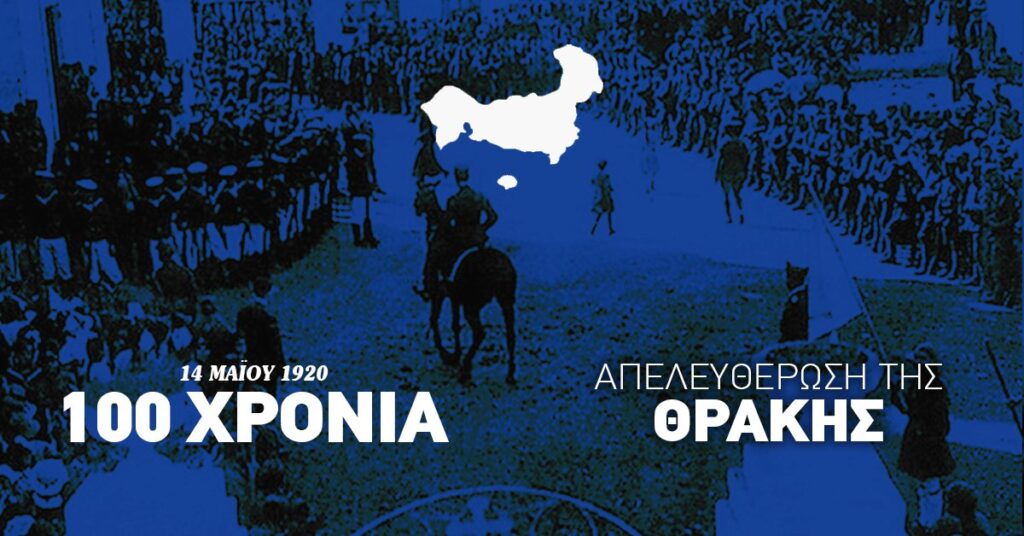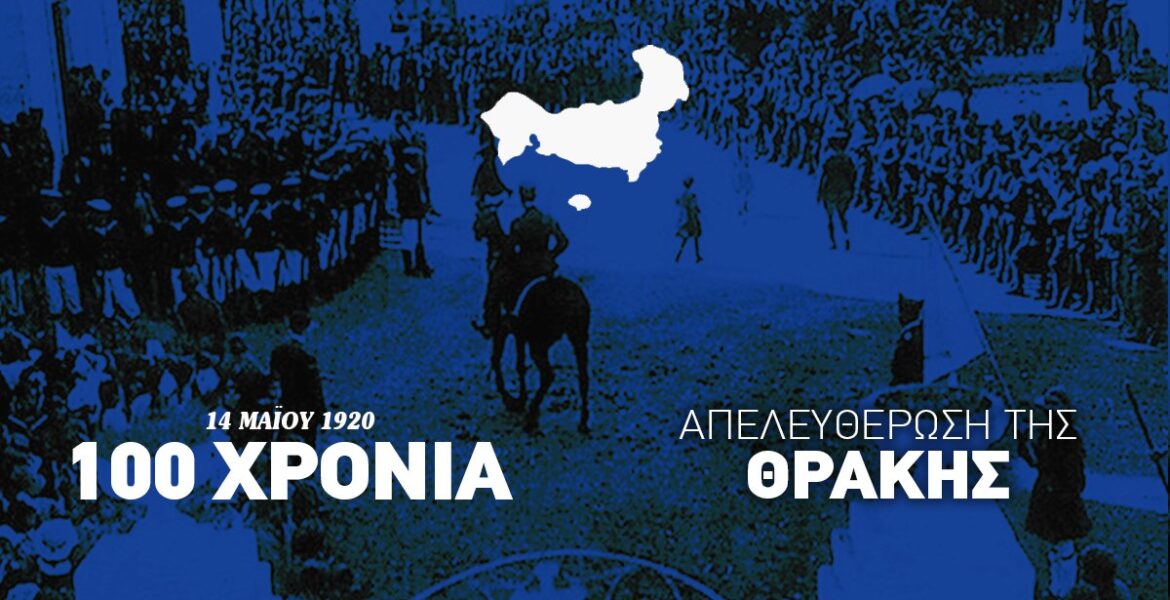
It was the early morning hours of May 14, 1920, when the advancing Greek army, entering the city of Komotini, victorious and liberating, were singing.
Their first verse: “Dawn dawned and we took Thrace.”
The nightmare of the Bulgarian occupation, an equally savage, perhaps even harsher than the German occupation, had finally ended, reported Orthodoxia News Agency.
“Thrace, after 600 years of slavery, was liberated in 1920. It was an attempt at militancy, resistance and, above all, passion and desire for freedom,” said Social Science Doctor Theofanis Malkidis to Evros24.
 Throughout the centuries, Thrace has been the “apple of discord” for two “suitors”, the Ottomans and the Bulgarians. What is shocking, however, is that this long-suffering region of the country has endured tyranny for two centuries more than any other region in Greece, for a total of 600 years, from 1360/70 to 1920.
Throughout the centuries, Thrace has been the “apple of discord” for two “suitors”, the Ottomans and the Bulgarians. What is shocking, however, is that this long-suffering region of the country has endured tyranny for two centuries more than any other region in Greece, for a total of 600 years, from 1360/70 to 1920.
During the escalation of Bulgarian nationalism and while there were already problems in the Greek Province of Eastern Romulia in Bulgaria, shortly before but mainly after the start of the First Balkan War, the Bulgarians gradually entered the present-day Rhodope Prefecture (then Guimultsina), but also the neighbouring prefectures of Xanthi and Evros, committing all kinds of atrocities against Christians and Muslims. In this way they occupied Thrace, the Bulgarian occupation which lasted from late 1912 to July 1913.
In the early hours of July 14, 1913, and since the previous day, the Bulgarians had begun to leave Komotini and the surrounding areas. The 1st Battalion of the Cretan Regiment under Captain Katehakis entered the town of Komotini, where its inhabitants, “Christians and Muslims, welcomed the liberating Greek army with indescribable enthusiasm. Men plus women and children came out after Greek flags, to welcome the coming army,” as reported by Theologos, Ecclesiastical Historian and Lawyer.
Thrace was temporarily liberated, but the joy did not last long.
The peace talks in Bucharest would prove painful as with the signing of the Treaty of Bucharest, Thrace was back under the rule of the Bulgarian state.
In the personal diary of Ion Dragoumis, it was written: “I feel sorry for Thrace… and for so many other Greek places, that we watered with so much blood, to leave them to the Serbs and to give them to the Bulgarians.”
Residents of Komotini, Christians and Muslims, when informed that their homeland had been ceded to the Bulgarians, sent a telegram to the Great Powers, signed by the local religious leaders of both religious communities, calling for the return to Greece, but in vain. From October 1913, the Second Bulgarian Occupation began, which lasted six years and was to prove to be worse than the first.
What happened during this occupation is described by the late Komotini University student Stilpona Kyriakidis in his historical work entitled “The Redemptive Thrace and the Bulgarians,” published in 1919.
It mentions the humiliations and the brutality he suffered. Muslims were baptised in the cold but in scorching water and in public, while their mosques had been turned into stables, barns and barracks. Thefts, disasters, rapes and all kinds of insults were a daily torment. Kyriakidis, after describing the death of Muslims by the Bulgarians, emphasised that their attitude towards Greek Christians was worse than what they had against Muslims and Jews.
This is exactly what the then Metropolitan of Maroneia (Μαρώνεια), Nicholas (1902-1914), referred to in detail in two letters to the Ecumenical Patriarch Germanos and the Holy Synod of the Ecumenical Patriarchate.
“The Bulgarians forbade the baptism of Greek children or funeral processions for dead Greeks, if their relatives do not renounce the Ecumenical Patriarchate and do not join the schismatic and irregular Bulgarian Patriarchate. As a result of this blackmail, the refusal of the relatives has the consequence that the infants remain unbaptised and the dead are buried without the legal exodus of a sequence and without the accompaniment of a priest. They accept to perform the sacraments in our churches, which, like our schools, they have taken by force of arms, if a Bulgarian priest and not a Greek Patriarchal priest is present. Our teachers and priests have been forcibly displaced and those who remain suffer. The names of the Greeks are being changed and Bulgarianised. They perform the divine services in the Bulgarian language without mentioning the name of the Ecumenical Patriarch and generally pressure the Greeks with threats, beatings and other means to speak the Bulgarian language in order to Bulgarianise them. They even went so far as to erase the Greek inscriptions from the icons of the Saints and from the crosses of the tombs in the Christian cemeteries and replace them with Bulgarian ones. Rape, theft, arson, destruction, beatings, threats, dishonour and humiliation are the daily torments of the Patriarchal flock in the province of Maroneia.”
The above-mentioned martyrdoms continued until October 1919, when Western Thrace came under Allied command, specifically under French military occupation.
At the same time, Harisios Vamvakas, then a representative of the Greek Government, was sent to the headquarters of the Allied administration in Komotini as a representative of the Greek Government. The two men managed to restore the ancestral homes of thousands displaced by the Bulgarians, return of the Churches and schools to the Christians, as well as the mosques to the Muslims, who had been forcibly occupied by the Bulgarians.
At the same time, consultations were being held on how Thrace could be integrated into Greece. And finally, Vamvakas in excellent agreement with Eleftherios Venizelos achieved the performance and integration of the western part of Thrace to Greece.
Thus, on May 13, 1920, the Greek army under Commander Zymbrakakis was ordered to head to the city of Komotini to be there on May 14.

Antonios Rossidis describes what happened on the night of the 13th and the dawn of the 14th of May in the “Chronicle of Liberation.”
“The joyful news of the decision of our allies to occupy western Thrace by the Greek army took wings and became immediately known to its inhabitants. In Komotini, on the eve of the entry of our army, everyone knew that the time was approaching and an unspeakable emotion and longing was painted on everyone’s faces. The old people of Komotini are shocked when they recall those unforgettable hours. That unforgettable night. No one slept. The whole city seemed to be watching all night. In the evening and throughout the night, men and women would come and go, led by the mayor Apostolos Soutzos, preparing the army’s reception. And you could hear laughter, wishes and happy songs everywhere. And when the first sunbeams of May 14, 1920, illuminated the clear blue sky, the whole city found itself floating in the blue and white. And the people of Komotini poured out to meet their liberators with shouts and exclamations of joy.”




